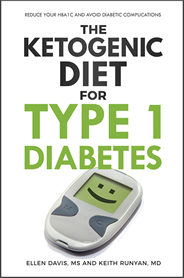Ketogenic Epilepsy Diet

An epilepsy diet, also known as a ketogenic diet, is a very-low-carbohydrate, very-high-fat diet used to control seizures. It has been in use since it was introduced by the Mayo Clinic in 1924. Although the diet is very effective, it fell out of favor with physicians when epileptic drugs came on the market.
The diet causes the body's energy systems to switch to burning fat as a primary fuel. This creates a state in the body called ketosis in which high levels of metabolized fat-derived products called ketone bodies circulate in the blood. These ketones or ketone bodies provide a source of fuel for brain cells and sooth the over-excited nerve cell mechanisms causing the seizures. There are many studies which discuss the specific biochemistry of a ketogenic diet's effect on the disease.
Being in ketosis has been shown in many research studies to be effective for children and adults suffering from epilepsy: in 10-25% of cases the dietary treatment completely eliminates seizures, and in most other cases, reduces seizures by 50-90%. This is a track record that no epileptic drug can match, and unlike the drugs, the diet has very few side effects, and those can be managed by a physician or dietitian knowledgeable in the proper implementation of a ketogenic diet.
For children on a classic ketogenic diet for epilepsy, the dietary ratio of fat intake is 3-4 times higher than the combined grams of protein and carbohydrate consumed. In adults, the ratio maybe 2-1, given the greater need for protein.
Expert organizations offering information, training and treatment include:
- The Charlie Foundation in the United States. The Charlie Foundation was established in 1994 to support research on ketogenic epilepsy diets for treating epilepsy, other neurological diseases and some cancers.
- In addition, Johns Hopkins Hospital in Baltimore, Maryland has an epilepsy team which runs one of the world's top ketogenic diet clinics offering treatment and research for both children and adults.
- In the UK, an organization called Matthew's Friends was started by a mother of a child with epilepsy.
The ketogenic epilepsy diet comes in at least four different forms:
- The classic ketogenic diet is the original form and requires a hospital stay. The classic ketogenic diet is administered based on specific fat to protein/carb ratios which change with patient age. Ratios can range from 4:1 to 1:1, based somewhat on the child's age and size.
- Another form of the diet includes MCT oil, an oil which the body metabolizes directly into ketone bodies. This form also requires a hospital stay.
- A third form of the diet is called the Low Glycemic Index Treatment and it is a 1:1 ratio, and can be started at home under a properly trained physician/dietitian's care.
- The fourth type is the Modified Atkins Diet which also uses a 1:1 ratio, and can also be started at home under a properly trained physician/dietitian's care. This diet has also been used to treat adults with epilepsy.
The patient's urinary ketones are measured and the goal is to adjust the diet so that the urinary ketones are kept in the moderate to high range (80–160 mg/dl). Higher fat to protein ratios have been shown to facilitate better seizure control. Recently, blood ketone meters have made ketone management easier.
Problems with Past Epilepsy Diet Protocols
Traditionally, the ketogenic diet was administered with a beginning fasting period, and restrictions on fluids and calorie intake, which made the diet much harder for the patient to bear. The fluid restrictions and anti-seizure medications such may have also contributed to the association of kidney stone development with the diet. As more research is done, current experts now recommend that potassium citrate supplement be administered with the diet.
Another criticism of the diet has to do with slowed growth in children. This is a consequence of dramatically restricting protein on the classic ketogenic diet. In addition, a lack of knowledge on nutritional issues and the use of old methods in administering the diets caused some tragic consequences which uneducated people take as a sign the diet is dangerous. Having read the case studies of children who died while on the diet, I believe these deaths had more to do with the quality of the fat and foods provided by the administering staff than the diet itself.
For example, the ketocal powdered shakes used to help simplify the diet administration are created from hydrogenated soybean oils and high fructose corn syrup, both of which have been shown in multiple studies to inflame the liver and pancreas. Giving these types of "long shelf life" products to children who were already ill had unintended consequences, and it is unfortunate that the diet was blamed instead of these badly designed products. Fortunately, a new product called Keto Kind is now available.
Millions of people put themselves on ketogenic "Atkins" style diets each year, and there has been no epidemic of pancreatitis, so it is logical to place the blame where it belongs: on these inflammatory pseudo-foods, and not the ketogenic diet.
Encouragingly, newer users of the ketogenic epilepsy diet are finding that good results can be achieved using real foods, even with lower fat to protein ratios. Some hospitals are pioneering the use of diet variations which allow for more food choices, such as the modified Atkins diet for adults being used at Johns Hopkins hospital.
Keto Kind instead of Ketocal
Keto Kind was developed by two young entrepreneurs in response to the need for a healthier, organic liquid meal product for people following a ketogenic diet. The product was developed following the latest science on ketogenic diets. The scientific advisory experts consulted in the development of this product include Dr. Nasha Winters, Miriam Kalamian, Dr. Brian Lenzkes, Dr. Keith Barr, Travis Christofferson and other long-term ketogenic experts.
More Information:
All of my books are available in electronic PDF, and now in paperback on Amazon!
 |
 |
 |
|
Buy paperbook on Buy paperback on Amazon Buy the e-Book via Paypal |
Buy paperback on Buy paperback on Amazon Buy the e-Book via Paypal |
Buy paperback on Buy paperback on Amazon Buy the e-Book via PayPal |